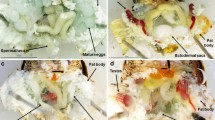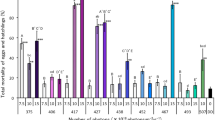Summary
Wyeomyia smithii Coq. (Diptera: Culicidae) overwinters as a larva in a state of diapause which is initiated, maintained, and terminated by photoperiod. Both in the dawn and in the dusk, diapausing larvae are photoperiodically most sensitive to blue light (390–450 nm) with a shoulder in response in the bluegreen and green (480–540 nm) region of the spectrum. The saturation curves for response to blue light in the dusk has a steeper slope than for response to blue-green and green light in the dusk, suggesting two distinct pigments or pigment complexes underly photoperiodic response in W. smithii.
The photic environment of W. smithii during twilight is rich in yellow-green light but sufficient light is available at 390–540 nm to trigger photoperiodic response early during morning civil twilight and to sustain response until late in evening civil twilight. Comparison of action spectra with spectra of available light indicates that the zenith angles of the sun which would result in 50% response are 95°48′ and 94°52′ in the dawn and dusk, respectively. Using these zenith angles to approximate daylength in nature provides a resonable prediction of development in the field.
The flux density of photons necessary to elicit 50% development a 454 nm is about 9×107 photons/cm2 s in the dawn and 3×108 photons/cm2 s in the dusk. This high degree of sensitivity enables W. smithii to cue to the rapidly changing light intensity which occurs around the nautical-civil twilight transition. At the same time, the chromophore is not likely to be stimulated by the light of the full moon.
Similar content being viewed by others
References
Barker, R.J., Cohen, C.F., Mayer, A.: Photoflashes: A potential new tool for control of insect populations. Science 145, 1195–1197 (1964)
Beach, R.F., Craig, G.B.: Photoinhibition of diapause in field populations of Aedes atropalpus. Environ. Entomol. 8, 392–396 (1979)
Beck, S.D.: Insect photoperiodism. New York: Academic Press 1968
Bradshaw, W.E.: Action spectra for photoperiodic response in a diapausing mosquito. Science 172, 1361–1362 (1972)
Bradshaw, W.E.: Photoperiodic control of development in Chaoborus americanus with special reference to photoperiodic action spectra. Biol. Bull. 146, 11–19 (1974)
Bradshaw, W.E., Holzapfel, C.M.: Interaction between photoperiod, temperature, and chilling in dormant larvae of the treehole mosquito, Toxorhynchites rutilus Coq. Biol. Bull. 152, 147–158 (1977)
Bradshaw, W.E., Lounibos, L.P.: Photoperiodic control of development in the pitcher-plant mosquito, Wyeomyia smithii. Can. J. Zool. 50, 713–719 (1972)
Bradshaw, W.E., Lounibos, L.P.: Evolution of dormancy and its photoperiodic control in pitcher-plant mosquitoes. Evolution 31, 546–567 (1977)
Bünning, E.: The adaptive value of circadian leaf movements. In: Biochronometry (M. Menaker, ed.), pp. 203–211. Washington: National Academy of Sciences 1971
Bünning, E., Joerrens, G.: Tagesperiodische antagonistiche Schwankungen der Blau-violett- und Gelbrot-empfindlichkeit als Grundlage der photoperiodischen diapause-Induktion bei Pieris brassicae. Zeit. Naturforsch. 15, 205–213 (1960)
Claret, J.: Sensibilité spectrale des chenilles de Pieris brassicae (L.) lors de l'induction photopériodique de la diapause. C. R. Acad. Sci. Paris. Serie D 274, 1727–1730 (1972)
Claret, J.: Le domaine de photosensibilité due parasite Pimpla instigator F. (Hymenoptère, Ichneumonidae) lors de l'entrée et de la levée photopériodiques de la diapause. C. R. Acad. Sci. Paris Serie D 276, 3163–3166 (1973a)
Claret, J.: La levée photopériodique de la diapause nymphale de Pieris brassicae (L.). C. R. Acad. Sci. Paris Serie D 277, 733–735 (1973b)
Dickson, R.C.: Factors governing the induction of diapause in the oriental fruit moth. Ann. Entomol. Soc. Amer. 42, 511–537 (1949)
Evans, K.W., Brust, R.A.: Induction and termination of diapause in Wyeomyia smithii (Deptera: Culicidae), and larval survival studies at low and subzero temperatures. Can. Entomol. 104, 1937–1950 (1972)
Galston, A.W.: Plant photobiology in the last half-century. Plant Physiol. 54, 427–436 (1974)
Geyspitz, K.F.: On the mechanism of light stimuli perception during photoperiodic reaction in caterpillars of Lepidoptera. Zool. Zhur. 36, 548–549 (1957)
Harris, F.A., Lloyd, E.B., Lane, H.C., Burt, E.C.: Influence of light on diapause in the boll weevil. II. Dependence of diapause response on narrow bands of visible radiation and a broad band of infrared radiation used to extend the photoperiod. J. Econ. Entomol. 62, 854–857 (1969)
Hayes, D.K.: Action spectra for breaking diapause and absorption spectra of insect brain tissue. In: Biochronometry (M. Menaker, ed.), pp. 392–402. Washington: National Academy of Sciences 1971
Hendricks, S.B., Borthwick, H.A.: The function of phytochrome in regulation of plant growth. Proc. Nat. Acad. Sci. U.S. 58, 2125–2130 (1967)
Kogure, M.: Influence of light and temperature on certain characters of the silkworm, Bombyx mori. J. Dept. Agric. Kyushu Imp. Univ. 4, 1–93 (1933)
Lees, A.D.: Photoperiodic timing mechanisms in insects. Nature 210, 986–989 (1966)
Lees, A.D.: The relevance of action spectra in the study of insect photoperiodism. In: Biochronometry (M. Menaker, ed.), pp. 372–380. Washington: National Academy of Sciences 1971
Lounibos, L.P., Bradshaw, W.E.: A second diapause in Wyeomyia smithii: seasonal incidence and maintenance by photoperiod. Can. J. Zool. 53, 215–221 (1975)
Mangum, C.L., Earle, N.W., Newson, L.D.: Photoperiodic induction of diapause in the boll weevil Anthonomus grandis. Ann. Entomol. Soc. Amer. 61, 1125–1128 (1968)
Mitrakos, K., Shropshire, W. (eds.): Phytochrome. New York: Academic Press 1972
Müller, H.J.: Über die Wirkung verschiedener Spektralbereiche bei der photoperiodischen Induktion der Saisonformen von Euscelis olebejus Fall. (Homoptera: Jassidae). Zool. Zb. 70, 411–426 (1964)
Munz, F.W., McFarland, W.N.: The significance of spectral position in the rhodopsins of tropical marine fishes. Vis. Res. 13, 1829–1874 (1973)
Nielsen, E.T.: Illumination at twilight. Oikos 14, 9–21 (1963)
Norris, K.H., Howell, F., Hayes, D.K., Adler, V.E., Sullivan, W.N., Schecter, M.S.: The action spectra for breaking diapause in the codling moth, Laspeyresia pomonella (L.), and the oak silkworm, Antheraea pernyi Guer. Proc. Nat. Acad. Sci. U. S. 63, 1120–1127 (1969)
Pittendrigh, C.S., Eichorn, J.H., Minis, D.H., Bruce, V.G.: Circadian systems, VI. Photoperiodic time measurement in Pectinophora gossypiella. Proc. Nat. Acad. Sci. U. S. 66, 758–764 (1974)
Rozenberg, G.V.: Twilight. A study in atmospheric optics. New York: Plenum Press 1966
Saunders, D.S.: Spectral sensitivity and intensity thresholds in Nasonia photoperiodic clock. Nature 253, 732–734 (1975)
Smith, S.M., Brust, R.A.: Photoperiodic control of maintenance and termination of larval diapause in Wyeomyia smithii (Coq.) (Diptera: Culicidae) with notes on oogenesis in the adult female. Can. J. Zool. 49, 1065–1073 (1971)
Tauber, M.J., Tauber, C.A.: Natural daylengths regulate insect seasonality by two mechanisms. Nature 258, 711–712 (1975)
Tauber, M.J., Tauber, C.A.: Insect seasonality: diapause maintenance, termination, and post-diapause development. Ann. Rev. Entomol. 21, 81–107 (1976)
Vinogradova, E.B.: The pattern of reactivation of diapausing larvae in the blowfly, Calliphora vicina. J. Insect Physiol. 20, 2487–2496 (1975)
Wilde, J.E. de, Bonga, H.: Observations on threshold intensity to different wave lengths of photoperiodic response in the Colorado beetle (Leptinotarsa decemlineata Say). Entomol. Expl. Appl. 1, 301–307 (1958)
Williams, C.M., Adkisson, P.L.: Physiology of insect diapause. XIV. An endocrine mechanism for the photoperiodic control of pupal diapause in the oak silkworm, Antheraea pernyi. Biol. Bull. 128, 511–525 (1964)
Williams, C.M., Adkisson, P.L., Walcott, C.: Physiology of insect diapause. XV. The transmission of photoperiod signals to the brain of the oak silkworm, Antheraea peryi. Biol. Bull. 128, 497–507 (1965)
Author information
Authors and Affiliations
Rights and permissions
About this article
Cite this article
Bradshaw, W.E., Phillips, D.L. Photoperiodism and the photic environment of the pitcher-plant mosquito, Wyeomyia smithii . Oecologia 44, 311–316 (1979). https://doi.org/10.1007/BF00545233
Received:
Issue Date:
DOI: https://doi.org/10.1007/BF00545233




